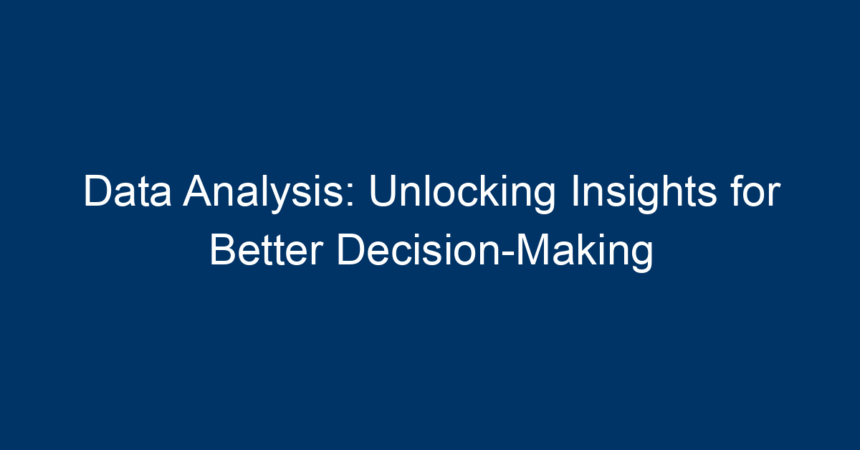In today’s fast-paced digital landscape, organizations are inundated with vast amounts of data. From customer behavior and sales trends to operational metrics, the potential insights contained within this data can be a game changer. However, the ability to harness these insights hinges on effective data analysis. This article explores how data analysis empowers businesses to uncover valuable insights, make informed decisions, and ultimately drive strategic initiatives.
Understanding Data Analysis
What is Data Analysis?
Data analysis refers to the systematic process of inspecting, cleaning, transforming, and modeling data with the aim of discovering useful information, supporting decision-making, and drawing conclusions. This process encompasses various techniques and tools that help distill complex data sets into understandable insights.
Importance of Data Analysis
In a world where data is often dubbed the “new oil,” its importance cannot be overstated. Effective data analysis enables organizations to:
- Identify Trends: Recognizing patterns in customer behavior helps businesses anticipate market shifts.
- Enhance Customer Experience: Analysis of feedback and purchasing behavior allows companies to tailor their offerings better.
- Optimize Operations: Understanding operational metrics can lead to improved efficiency and reduced costs.
The Data Analysis Process
Step 1: Data Collection
The first step in any data analysis endeavor is collecting relevant data. This can come from various sources, including:
- Surveys and Feedback Forms: Direct customer insights.
- Web Analytics: Visitor behavior on websites.
- Sales Data: Historical performance metrics.
Step 2: Data Cleaning
Before diving into analysis, it’s crucial to clean the data. This involves:
- Removing Duplicates: Ensuring that each data entry is unique.
- Addressing Missing Values: Using techniques like imputation or exclusion to handle gaps.
- Standardizing Formats: Making sure all data follow a consistent format (e.g., date formats, currencies).
Step 3: Data Analysis Techniques
Several techniques are employed during data analysis, depending on the nature of the data and the insights sought. Here are some popular methods:
Descriptive Analysis
This technique provides a summary of historical data, often through metrics like means, medians, and modes. For instance, a retail business might analyze past sales data to determine average sales per month.
Inferential Analysis
Inferential analysis goes a step further, using samples to make generalizations about a population. This is particularly useful in hypothesis testing and confidence intervals.
Predictive Analysis
Using statistical models and machine learning algorithms, predictive analysis forecasts future trends based on historical data. A classic example is predicting customer churn based on previous buying patterns.
Prescriptive Analysis
This goes beyond predictions to recommend actions. For example, a business may use prescriptive analysis to determine the optimal price for a product based on market conditions and consumer behavior.
Step 4: Interpretation and Reporting
Once the analysis is complete, the next step is to interpret the results. Here, clarity is paramount. Data visualization tools, such as charts and graphs, can help convey complex information succinctly. These visual aids enable stakeholders to grasp insights quickly.
Tools for Data Analysis
The right tools can greatly enhance the data analysis process. Here are some popular options:
- Excel: While basic, its pivot tables and graphing capabilities are powerful for many small-scale analyses.
- Tableau: A leading data visualization tool that helps present data insights visually.
- R and Python: These programming languages offer extensive libraries for statistical analysis and machine learning.
- SQL: Essential for querying and managing databases efficiently.
Real-World Applications of Data Analysis
Marketing
In marketing, data analysis is used to segment audiences, personalize campaigns, and measure ROI. By analyzing customer behavior, marketers can tailor their messaging to increase engagement rates.
Healthcare
The healthcare industry leverages data analysis to track patient outcomes, manage resources, and predict outbreaks. By analyzing historical patient data, healthcare providers can improve treatment strategies.
Finance
In finance, data analysis helps investors identify trends, assess risk, and make informed trading decisions. Historical data can guide investment strategies and optimize portfolios.
Operations
By analyzing operational data, businesses can identify inefficiencies and streamline processes. For example, a logistics company might use data analysis to optimize delivery routes, reducing operational costs and improving delivery times.
Challenges in Data Analysis
Despite its benefits, data analysis comes with challenges:
- Data Overload: The sheer volume of data available can be overwhelming. Businesses must focus on what data is most relevant to their objectives.
- Quality of Data: Poor data quality can lead to inaccurate conclusions. Continuous efforts must be made to ensure data integrity.
- Skill Gap: Many organizations struggle with a lack of skilled analysts. Investing in training or hiring experts can mitigate this issue.
The Future of Data Analysis
As technology continues to evolve, so does data analysis. The rise of artificial intelligence (AI) and machine learning will further enhance the capabilities of data analysis tools, allowing businesses to extract deeper insights with greater accuracy. Additionally, as more organizations embrace a data-driven culture, the value of data analysis will only continue to grow.
Conclusion: Actionable Insights for Better Decision-Making
Data analysis is not merely a function; it is a strategic imperative for success in the modern business landscape. By understanding and applying data analysis techniques, organizations can unlock powerful insights that inform better decision-making.
Key Takeaways:
- Invest in Data Collection: The accuracy and relevance of your insights depend significantly on the quality of data collected.
- Focus on Data Cleaning: Prioritize this step to ensure data integrity and accuracy in analysis.
- Leverage Advanced Tools: Utilize the right tool for the job to enhance your data analysis capabilities.
- Embrace Continuous Learning: Keep up with emerging trends in data analysis to remain competitive.
- Promote a Data-Driven Culture: Encourage all employees to embrace data analysis in their decision-making processes.
By effectively harnessing the power of data analysis, businesses can stay ahead of the curve and drive innovative solutions that enhance growth and efficiency. Ultimately, the goal is not just to collect data but to turn it into actionable insights that guide strategic decisions for long-term success.




